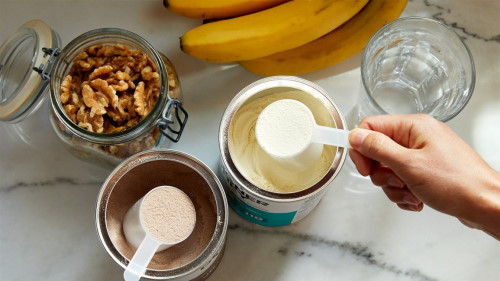When people think of “diet foods,” the first thing they think is “boring and bland.” Dry chicken breast, canned tuna, steamed broccoli, and salads, for example, don’t exactly tantalize the taste buds. But you know you need to eat healthier, so you add it to the menu. Then, to make these foods a bit more appealing, you grab the nearest condiment and pour it on generously, hoping to add some extra flavor and improve the texture.
Unfortunately, if you’re not careful, you can take an extremely healthy food and quickly transform it into something that’s not so good for you—if not downright unhealthy. In short, drowning your food in an overgenerous serving of sauce or spread can overwhelm the food with calories, sugar, refined fats, or additives. Plus, you may never discover how tasty and flavorful these foods can be on their own.
BREAKING: Newly Legalized Herb Relieves Pain - Available Without A Prescription
Which sauces and spreads can “ruin” your healthy meal? And are there any options you can safely use instead, without adding a bunch of junk?
8 Sauces and Spreads That Ruin Healthy Food
1. Ketchup
If you reach for the average bottle of store-bought ketchup to liven up your meal, you may quickly overwhelm your tastebuds with sugar and additives. One of the first three ingredients in most ketchups is high-fructose corn syrup or sucrose (i.e., table sugar) or both. One tablespoon may only contain 19 calories, but 3.7 grams (~one teaspoon) of that is sugar. And it’s so easy to squeeze a few extra tablespoons over your plate.
Is a single packet of ketchup going to kill you? No. But if you’re dousing all the food on your plate, the calories and sugar add up, and it can be tough to track the serving size from a squeeze bottle.
Instead, there’s another tomato-based option that makes a lower calorie, lower sugar, lower sodium topping for burgers, baked fries, or even mixed into tuna: fresh salsa.
2. BBQ Sauce
Another calorie- and sodium-rich condiment is barbecue sauce. Some brands pack as many as 35 calories and 250 mg of sodium per tablespoon, yet the average serving is often as many as 6 tablespoons, adding up to 200 or more calories.
If you want some BBQ sauce on your chicken or black bean burger, go for it. Just watch to avoid drenching them with calories. Better yet, make your own with this healthier version.
3. Creamy Salad Dressings
Who doesn’t love a big salad drenched in ranch, cheese, and maybe some croutons? Of course, if you’re trying to cut calories, this will quickly set you back. In fact, a salad like this could provide more calories than a Big Mac. And some restaurant salads add up to over 1,000 calories!
Much of that is due to the creamy, calorie-dense ranch (or blue cheese) dressing that adds an extra 200 or more calories.
4. Fat-Free Salad Dressings
Okay, so instead of a creamy ranch or blue cheese, just grab a fat-free version over your regular, right? Unfortunately, many of these fat-free versions play tricks with servings sizes (i.e., the serving size is half of what you would typically see with a full-fat version). Worse, the fat-free dressings often try to make up for the flavor lost from the fat by adding excess sugar, sodium, or other additives. (Some store-bought varieties pack as much as 350 mg of sodium per serving.)
Finally, when using fat-free dressings, you could be inadvertently decreasing the nutrients your body absorbs from the vegetables in your salad. Many vitamins and antioxidants (e.g., vitamins D, E, K, and beta-carotene and lycopene) attach to fat to be transported through the body. That is, eating many vegetables with fats actually increases the nutrition value.
Instead of going for a fat-free version, simply measure out a true serving of a healthy full-fat version. Here are three tasty options you can make in minutes.
5. Mayonnaise
With an average of 90 calories and 125 mg of sodium per single tablespoon serving, mayo can take a healthy sandwich or salad and turn it into a calorie-laden indulgence in seconds.
A healthier creamy option is Greek yogurt. You’ll cut both calories and sodium while adding a nice dash of protein and calcium. You can make it even more flavorful by adding herbs and spices to the mix—try garlic and basil, lime and cilantro, chive and black pepper, or even just a dash of lemon juice.
6. Pancake Syrup
Most syrup contains little, if any, actual maple syrup. Instead, it’s typically made up of high-fructose corn syrup (HFCS). The problem is that HFCS has been linked to a higher risk for obesity, type 2 diabetes, and even heart disease.
If you want some syrup on your pancakes or waffles, go with the real thing—maple syrup. Or, for a lower impact on your blood sugar levels, as well as to decrease calories and increase nutrients, toss on some fresh berries instead with maybe a drizzle of maple syrup.
7. Queso
This popular cheese sauce is rich in calories and it’s also often loaded with unhealthy additives like MSG (monosodium glutamate), which may promote weight gain.
Instead, choose to make your own healthy cheese sauce or even try nutritional yeast for a cheesy flavor without all the calories and, well, other crap.
8. Teriyaki Sauce
You’re making a healthy, veggie-filled stir fry, topped with a delicious teriyaki sauce. So yummy. Unfortunately, these sauces are often excessively high in both sodium and sugar. Watch labels closely or, better yet, make your own, so you can better control the calories and additives.
Simple versions use ingredients like pineapple juice, low-sodium soy sauce, maple syrup, rice wine vinegar, and sesame oil, as well as garlic, ginger, and pepper, and they can be made in minutes.
Healthier Sauces and Spreads to Use Instead
Now that you know what sauces to watch out for, what can you add instead to liven up your healthy meals? Below are some good options—as long as you are making your own or at least checking the labels on store-bought items to make sure they aren’t loaded with sodium, sugars, artificial flavors and colors, or other junk you’d rather avoid.
1. Pesto is made from fresh basil, olive oil, parmesan or Romano cheese, and pine nuts. This nutrient-rich addition goes great on baked or grilled chicken, over zoodles or pasta, or even as a sandwich spread.
2. Salsa provides an abundance of rich flavors with only 10 calories per 2 tablespoons. Of course, it’s common to add to tacos or tostados, but it also goes great on eggs, or in lieu of a salad dressing.
3. Mustard is a common condiment that easily wins as the healthiest option over ketchup and mayo. It’s one of the lowest in calories (only 6 calories per 2-teaspoon serving). It also adds a great pop of flavor in salad dressings, marinades, or brushed onto fish or chicken before baking or grilling.
4. Kimchi is best known for its probiotic benefits, as it’s made from fermented vegetables. It’s also a great addition to stir-fries, noodles, rice, and even on sandwiches.
5. Sauerkraut is another one rich in beneficial bacteria. And it’s also low in calories (only 7 per ¼ cup). Try it on top of a sandwich, salad, coleslaw, pot roast, and more. (Just make sure you’re getting the fermented version from the refrigerated section for greater health benefits.)
6. Hummus provides flavor, protein, and fiber to help improve digestion and keep you going longer. It’s great with vegetables as a dip or mixed in as a dressing or as an alternative to mayonnaise on a sandwich.
7. Vinegar—from apple cider to balsamic to port and more (just avoid white vinegar which can be harsh)—can easily add a special tang to many meals. Try a drizzle over a salad or as part of a tangy marinade.
8. Nutritional yeast is often used in vegan cooking as it has a “cheese-like” flavor. It’s also rich in vitamin B12. It can be added to soups, sauces, or sprinkled over popcorn, eggs, or even potatoes.
TRENDING: Shed 42 lbs In 30 Days With This Simple Night-time Pill
Of course, even when you make better choices, the calories can add up, so don’t go overboard thinking serving sizes don’t matter.
Another common element in some of the lower-calorie sauces, spreads, and condiments is sodium. Soy sauce (902 mg per tablespoon), hot sauce (which varies depending on the brand), and steak sauce (up to 560 mgs), for example, can provide way too much sodium for one meal, increasing the risk for high blood pressure as well as heart and kidney disease when used regularly.
So, remember, a little can go a long way while still providing big flavor to any old “boring” meal!









